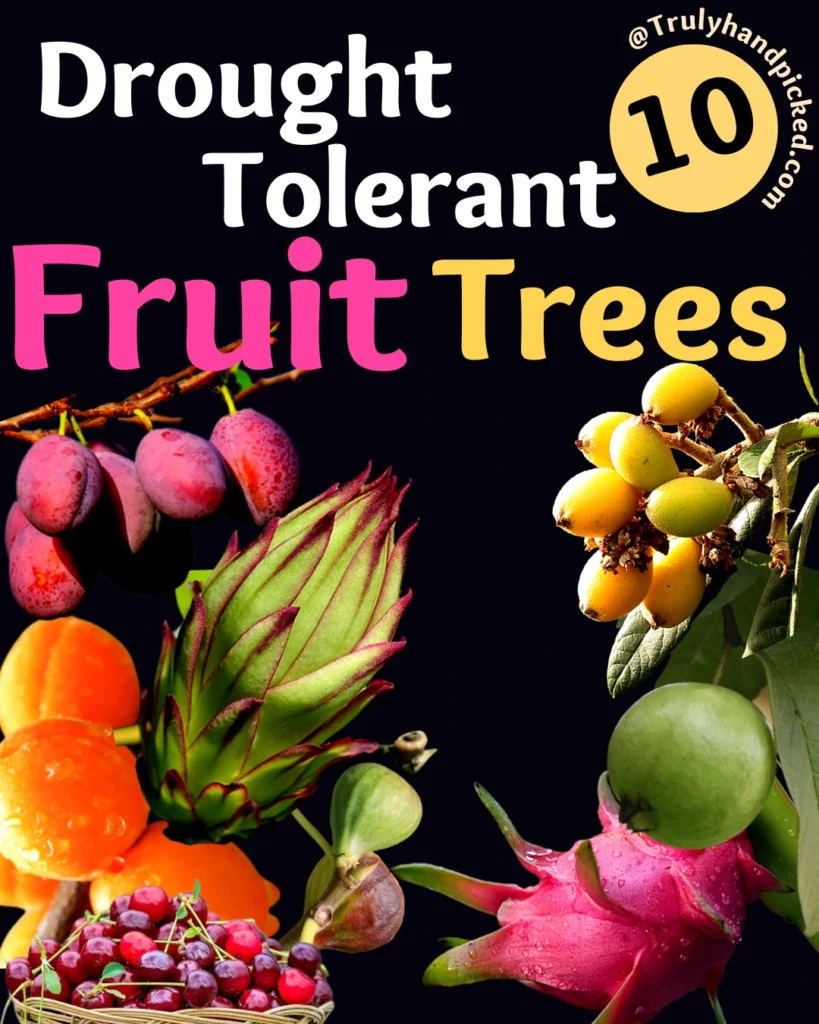What’s here: list of best drought-tolerant fruit trees, how to care for them, fruit trees for zone 9, 5, 6, California, and Texas, and best fruit trees for each region(zones).
Expanding the backyard or front area with fruit trees is definitely a smart idea indeed. Fruit trees are challenging to cultivate and even more exciting to harvest.
But, people, who live in areas with less rain or dry air, seem afraid to take this challenge. Cropping trees are more demanding and need a consistent climate to grow fruits.
However, some drought-tolerant fruit trees are like boons in such matters. These trees can stand the hardest growing conditions and yet produce crops of the utmost amount.
So, today, we emerge with the best 10 of those drought-tolerant fruit plants that can easily thrive in your orchard with the least growing essentials-
Drought-Tolerant Fruiting Trees For Your Backyard
Cherry:
Details:
Growing a cheery tree in your yard is quite easy as this sweet fruit plant is less demanding in real. A fully mature cherry tree can reach up to 35 ft. tall with a wide spread of 14 feet.
Growing Tips:
- Use moderately fertile and well-drained soil to sow our cherry plant
- It has a shallow root system, thus, water your plant regularly for the first 1-2 years
- Keep the soil evenly moist under good air circulation in a sunny spot
- Feed your plant with a balanced fertilizer twice a year with a 3-1-1 NPK ratio
Fruiting Season: Summer to fall
How long to Start Fruits: Dwarf trees can yield from 12-14 months, while normal trees will take four years to give fruits
Hardiness Zones: 5 to 7
Related: Best drought-tolerant vegetable for your garden
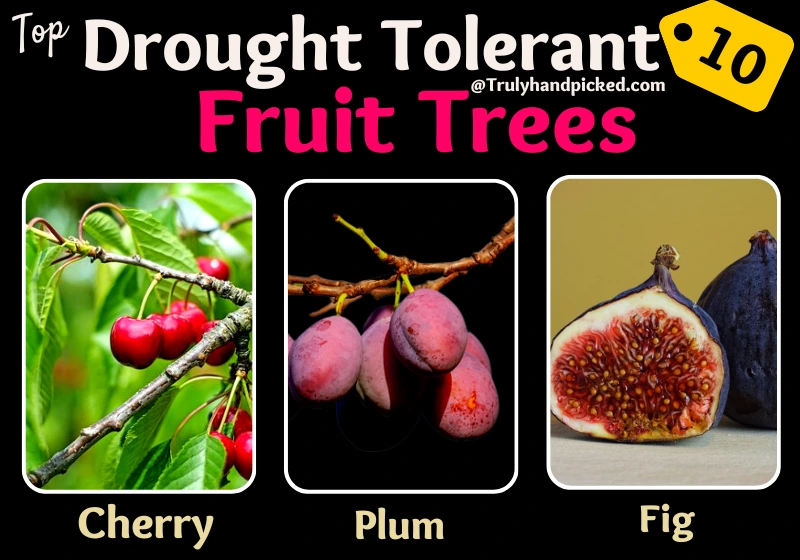
Plum:
Details:
Plum or natal plum grows tasty fruits like cranberries along super catchy star-shaped white blossoms. It can thrive up to 6-7 feet tall with a 4-5 ft. widespread. It is a tropical shrub that cultivates for its attractive landscaping views as well, alongside its tasty fruits.
Growing Tips:
- Grow your plant in sandy, well-drained soil with a slightly acidic pH level
- Place your plant under a full spot with good circulation
- Water your plant once a week with 1-inch deep watering and let the soil dry between watering
- Feed your plant two to three times per year with a fully balanced commercial fertilizer
How does it take to bear fruit: It takes nearly 3 -5 years for a normal plum tree to produce fruits, while dwarf will start in a year or two.
Cropping Season: Fall to summer
Hardiness Zones: 9 to 11
Related: Best drought tolerant plants – easy to grow
Fig:
Details:
Ficus carica aka fig is a sweet fruit with deep ancient value. It considers one of the first domesticated crops of human civilization. This tropical tree grows green flowers with small pear-shaped purplish fruit that is a syconium.
Growing Tips:
- Sow your fig plant in organically rich soil with well-drained quality and neutral pH
- Place your plant under full sun exposure
- Water your growing figs once every 7-10 days and apply mulching after the first few months of plantation
- Keep your plant well fertilized for the utmost time by feeding them with a granulated slow-release fertilizer twice a year
When does my fig tree start to produce: A fig tree starts to bear fruits from its 4th year on average.
Harvest Season: Late winter
USDA Hardiness Zones: 6 to 9
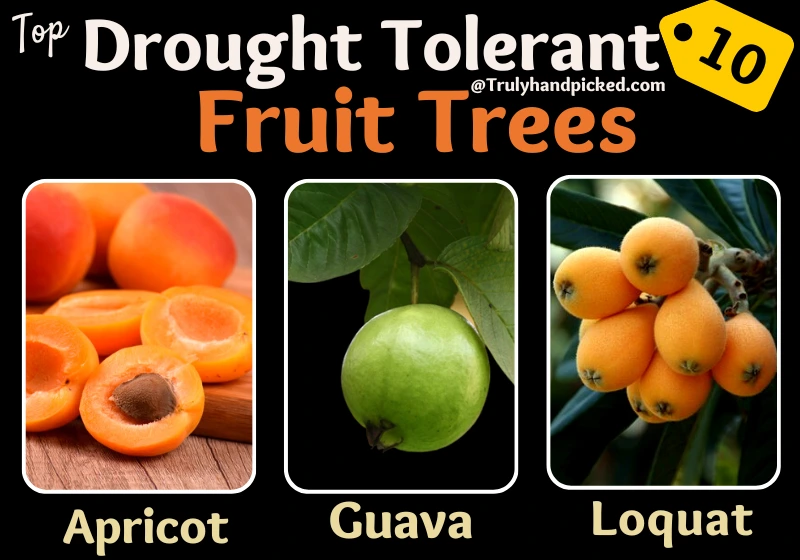
Apricot:
Details:
The Apricot is a highly fragrant fruit tree that is noted for its ornamental landscaping view, apart from its scrumptious crops. This plant produces dainty blossoms with juicy fruits. A tree can thrive up to 20-30 ft. tall with an equal amount of widespread.
Growing Tips:
- Plant the tree in an averagely fertile, well-drained soil with a slightly alkaline pH level
- It is a low drought-tolerant thus, you need to water it more frequently than the other equivalents from the list
- Water your plant weekly and put it under full sun exposure
- Feed your growing tree once or twice a year with any low-nitrogen all-purpose fertilizer
When will my apricot tree produce fruits: A young tree will bear fruits from its 3rd to 4th year.
Peak fruiting Season: Summer
Hardiness Zones: 5 to 8
Related: Native California plants that manage with less water – drought tolerant
Guava:
Details:
Guava is a broadleaf evergreen cropping tree that has minimal to no growing needs at all. It produces green pear-shaped super tasty fruits which are high in nutr3eint value. A mature outdoor plant can grow up to 20 feet tall with a multi-stemmed trunk.
Growing Tips:
- Sow your plant in organically rich, well-drained soil with an acidic pH level
- Let it thrive under full sun exposure
- Water your guava plant regularly during summer days and skip the watering during winter
- Fertilize your plant with any weak liquid fertilizer once to twice a year
How long for the guava tree to bear fruits: Your guava tree will start to produce delicious fruits from its 3rd year.
Harvest Season: Winter, spring, and rainy season
Hardiness Zones: 9 to 11
Related: Cute indoor plants that Grow in water
Loquat:
Details:
Japanese plum aka loquat is another drought-tolerant fruit tree that needs the least care to thrive. Despite being a drought-tolerant plant, it can’t stand extreme cold temperatures in its entire life span. This long-leaf cropping tree can grow up to 25 ft tall with equal spread when fully matured.
Growing Tips:
- You need to use loamy, rich, and well-drained soil with a neutral pH balance
- Let your plant soak enough sun with full exposure
- Water your plant weekly with 1-inch deep watering for a better cropping experience
- And you can feed your plant three to four times a year with a balanced commercial fertilizer
How long for a loquat tree to bear fruits: Normal loquat trees (from seed) will take more than 6+ years to mature and bear fruits. while grafted loquat trees can bear fruit from their 3rd year.
Fruiting Season: Late summer into fall
Hardiness Zones: 8 to 10
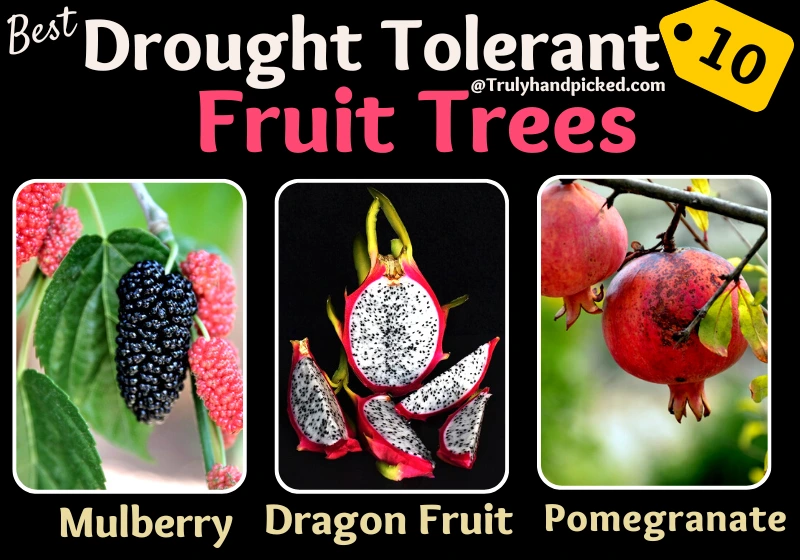
Mulberry:
Details:
If you are a berry-fruit lover and have enough space in your yard, go for this option undoubtedly. The Mulberry plant is a quick grower that produces berries analogous to blackberries but only in red and white shades. Its dark green foliage with jagged edges looks catchy around crop clusters. A mature plant can grow up to 60 ft. tall with a 30-40 ft. spread.
Growing Tips:
- Plant your tree in a rich and moist well-drained soil with a slightly acidic pH level
- Give your plant 6-8 hours of the bright sun under full sun exposure
- Water it deeply about 2-3gallons of water each week during the first season
- And feed your plant with a balanced all-purpose fertilizer once a year
When does a mulberry tree bear fruit: Few can start to produce from its 3rd year, while the average mulberry tree grown from seeds will take more than 6+ years.
Fruiting Season: After the onset of the monsoon
USDA Hardiness Zones: 4 to 8
Related: Best climbing plants and vines with fruits
Dragon Fruit:
Details:
Dragon fruit is a desert-origin cacti species that produce edible fruits in an unusual shape. This fast-growing perennial plant produces super juicy starchy fruit in a vibrant pink shade. It can grow up to 20 ft. tall with a 10 ft. spread.
Growing Tips:
- You can use sandy, moderately rich, well-drained soil with a slightly acidic pH to sow this plant
- The long and fleshy cactus stalks thrive best under full sun to the sun with a bit of shade
- Water your plant two to three times a month and use mulching for the best result
- Feed them with a balanced fertilizer in a 20-20-20 NPK ratio every few months
How long for my dragon fruit tree to produce fruits: Few trees will proper care and the climate will bear fruits from its first year. While container grown trees and others take 2 to 3 years of time.
Harvest Season: August to December
Hardiness Zones: 10 to 12
Pomegranate:
Details:
Pomegranate is a dwarf shrub plant that is super easy to maintain in a normal home climate. The bonsai pattern tree produces scarlet red to pinkish red tuber fruits around glossy green foliage. a mature plant can grow 3 to 30 ft. tall, depending on its selective species.
Growing Tips:
- This plant doesn’t have many requirements for soil, just make sure it can drain well
- Place it under full sun exposure
- Water your growing plant deeply every two to four weeks, especially during winters
- Feed your plant with moderately rich balanced fertilizer two times a year
How long to bear fruits: Normally pomegranates will take 2 – 3 years to start bearing fruits, while few dwarf varieties and grafted will start from their first year.
Peak Season: The rainy season, winter, and autumn
Hardiness Zones: 7 to 10
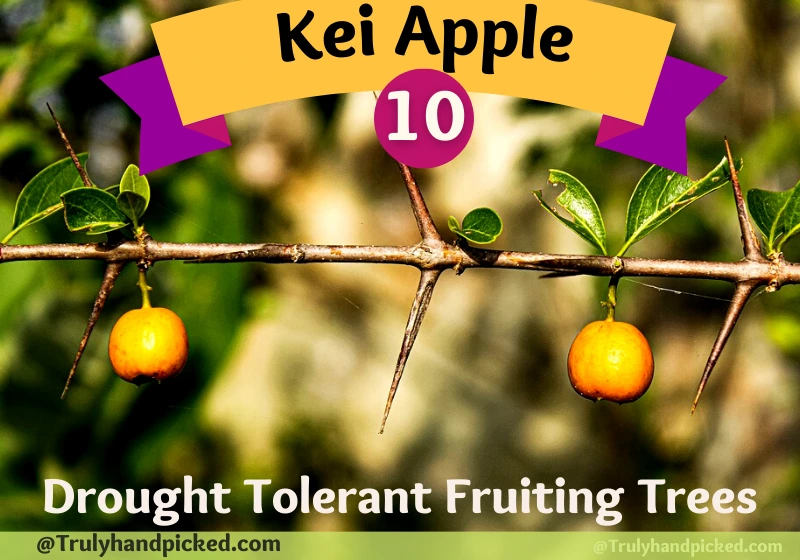
Kei Apple:
Details:
Kei apple is a slow-growing apple species plant that is native to the south-African forests. Despite being a slow grower, kei-apple can produce crops within the first to the second year of the plantation. It produces small yellowish apple fruits with glossy, thick green foliage.
Growing Tips:
- Use loamy, compost-rich well-drained soil with a neutral pH level to sow kei apple plant
- Place it under full sun exposure
- Hydrate your plant weekly with deep watering using high-quality water only
- Feed your pant annually with balanced plant food in a 20-20-20 NPK ratio
When will my kei apple start to fruit: Kei apple trees take 3-4 years to produce flowers and fruits.
Cropping Season: August to October
Hardiness Zones: 9 to 10
Drought Tolerant Fruit Trees: California Texas & Zone 5, 6, 9
Is this fruit tree suitable for my zone?
Apricot Tree – (Zone 5, Zone 6, Zone 9, California)
Highly adaptable and can thrive in a variety of zones, including Zone 5, Zone 6, Zone 9, and California. They are known for their deliciously sweet and juicy fruits, which are packed with vitamins and minerals.
These trees are drought-tolerant and can withstand hot and dry conditions, making them an excellent choice for regions with limited water availability.
Peach Tree – (Zone 5, Zone 6, Zone 9, California)
Well-suited for Zones 5, 6, 9, and California. They produce succulent and aromatic peaches that are perfect for enjoying fresh, baking into pies, or making preserves.
These trees are known for their adaptability to different soil types and their ability to thrive in areas with low water availability.
Pomegranate Tree – (Zone 5, Zone 6, Zone 9, California)
Grown in Zones 5, 6, 9, and California. They are prized for their stunning flowers and antioxidant-rich fruits.
Pomegranate trees are drought-tolerant and can handle hot and dry climates, making them a fantastic choice for regions where water conservation is important.
Fig Tree – (Zone 5, Zone 6, Zone 9, California)
Fig trees can flourish in Zones 5, 6, 9, and California. These trees offer sweet and luscious figs that are delightful to eat fresh or use in various culinary creations.
Fig trees are hardy and can tolerate drought conditions, making them an excellent choice for regions with limited water resources.
Citrus Trees (such as Orange, Lemon, and Lime) – (Zone 9, California)
Citrus trees, including oranges, lemons, and limes, thrive in Zone 9 and California’s Mediterranean climates. These trees produce juicy and tangy fruits that are rich in vitamin C.
While they require regular watering, they can still tolerate periods of drought, making them a popular choice in regions where water conservation is a concern.
Apple Tree – (Zone 5, Zone 6)
They offer a wide variety of apple flavors, textures, and colors, making them a versatile choice for home orchards. While they prefer moderate water availability, apple trees can adapt to drought conditions with proper care and maintenance.
Mulberry Tree – (Zone 5, Zone 6, Zone 9, California)
Trees produce sweet and juicy berries that are enjoyed by both humans and wildlife.
Mulberry trees are known for their tolerance to drought and can thrive in various soil types, making them a resilient choice for gardeners in regions with limited water resources.
Persimmon Tree – (Zone 5, Zone 6, Zone 9, California)
Persimmon trees can be cultivated in Zones 5, 6, 9, and California. These trees bear sweet and flavorful fruits that are consumed fresh or used in baked goods.
Persimmon trees are drought-tolerant and can adapt to different soil conditions, making them suitable for regions where water conservation is important.
Guava Tree – (Zone 9, California)
Produce tropical and aromatic fruits with unique flavor profiles.
Guava trees are known for their ability to tolerate drought conditions, making them an excellent choice for water-wise gardening in these regions.
Best Drought Tolerant Fruit Trees and Varieties for Each Region
Zone 3-4:
- Apple trees (varieties like ‘Haralson’ and ‘Prairie Magic’)
- Cherry trees (hardy cultivars like ‘Northstar’ and ‘Montmorency’)
- Plum trees (drought-tolerant varieties such as ‘Stanley’ and ‘Toka’)
- Raspberry bushes (specific cultivars like ‘Nova’ and ‘Boyne’)
- Haskap berries (also known as honeyberries, varieties like ‘Borealis’ and ‘Tundra’)
For Drought Zone 5-6:
- Apricot trees (drought-tolerant varieties like ‘Moongold’ and ‘Harglow’)
- Pear trees (drought-resistant cultivars like ‘Kieffer’ and ‘Ure’)
- Blueberry bushes (specific types like ‘Northblue’ and ‘Northcountry’)
- Blackberry bushes (varieties such as ‘Chester’ and ‘Triple Crown’)
- Elderberry shrubs (drought-tolerant species like ‘Adams’ and ‘York’)
Zone 7-8:
- Fig trees (drought-tolerant varieties such as ‘Celeste’ and ‘Brown Turkey’)
- Pomegranate trees (hardy types like ‘Russian 26’ and ‘Wonderful’)
- Persimmon trees (drought-resistant varieties like ‘Fuyu’ and ‘Hachiya’)
- Grapevines (specific cultivars like ‘Reliance’ and ‘Mars’)
- Mulberry trees (drought-tolerant species such as ‘Dwarf Everbearing’ and ‘Pakistan’)
Drought Zone 9-10:
- Citrus trees (drought-tolerant options like ‘Meyer lemon’ and ‘Satsuma mandarin’)
- Olive trees (varieties such as ‘Arbequina’ and ‘Koroneiki’)
- Mango trees (specific cultivars suitable for warmer climates like ‘Kent’ and ‘Irwin’)
- Avocado trees (drought-tolerant varieties like ‘Mexicola’ and ‘Bacon’)
- Guava trees (hardy types such as ‘Tropical Pink’ and ‘Ruby Supreme’)
Reference Links for Drought Tolerant Fruit Trees & Care
Buying and planting fruit trees: https://extension.umd.edu/resource/buying-and-planting-fruit-trees
Fruit trees what to plant: https://ucanr.edu/sites/AltsToCitrus-ACP-HLB/Fruit_Trees__What_to_Plant/
Pomegranate fruit of the desert: https://extension.usu.edu/yardandgarden/research/pomegranate-fruit-of-the-desert
Best drought-resistant fruit trees: https://sonomamg.ucanr.edu/Food_Gardening/Additional_KG_Articles/Fruit_Trees_in_a_Drought/
Citrus for backyard fruiting: https://site.extension.uga.edu/evansag/2020/12/planting-citrus-for-backyard-fruit/
Peach, apricot fruit trees: https://extension.umd.edu/resource/care-peach-cherry-nectarine-plum-and-apricot-trees-home-gardens
Caring for guava: https://plantvillage.psu.edu/topics/guava/infos
Handing drought – fruit and vegetables: https://cesonoma.ucanr.edu/SpecialtyCrops/Irrigation_-_Climate/Disaster_Resources/Drought__Vegetables_Fruit_Trees_-_Berries/
